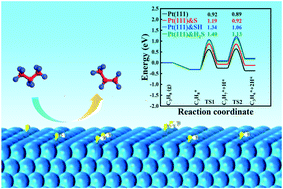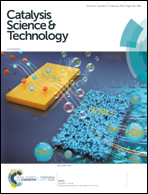The role of H2S addition on Pt/Al2O3 catalyzed propane dehydrogenation: a mechanistic study†
Abstract
Introducing sulfur species into Pt catalysts has been proven to be an effective method to improve their performance in various reactions. However, the role of sulfur addition on Pt catalysts catalyzing propane dehydrogenation (PDH) is still not clear. This work combines catalyst characterizations, catalytic kinetics studies and DFT calculations to understand the influence of H2S addition in the feed on Pt/θ-Al2O3 catalyzed PDH from a mechanistic perspective. With the addition of a trace amount of H2S in the feed (3 ppm), the propylene selectivity increases from 79% to 96% and the deactivation factor decreases from 33% to 18%, at the expense of a slight activity loss. The improved catalytic performance can be partially attributed to the electron transfer from sulfur species to Pt atoms as indicated by CO-DRIFTS results. DFT calculations show that H2S could be the dominating sulfur species on Pt particles and donate electrons to Pt atoms, which further proves that sulfur species improve the catalytic performance by donating electrons. In addition, the repulsion between sulfur species and C3 hydrocarbons also explains the improved catalytic performance.



 Please wait while we load your content...
Please wait while we load your content...